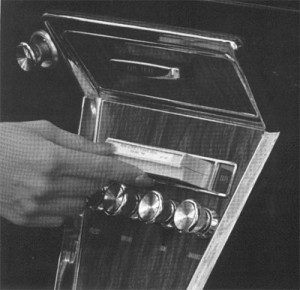 The 8-track was a distinctively American achievement in audio, reflecting the well-known fascination with automobiles in the U.S. Automotive record players, some of questionable utility, were available as original equipment or aftermarket add-ons from about 1958 to the mid-1960s. They never sold in great numbers, and were eclipsed by the advent of automotive tape systems. Small cartridge tape systems appeared in the middle 1950s as a variation of the “cart” system that came to be widely used for spot announcements in radio stations. This was based on an endless loop tape cartridge that had a long playback time (over two hours was possible). In the early 60s, an entrepreneur in California created a minor sensation with his “Stereo-Pak” auto tape system, and this was modified and reintroduced in a few years as the Lear Jet Stereo-8 (the parent company was acquired in 1967 and the spelling changed to “Learjet”). Made by the same firm that made Lear Jet airplanes, it was first installed in Ford cars in 1965. Soon all the American auto makers offered this technology as optional equipment, and home and portable versions of the players appeared.
The 8-track was a distinctively American achievement in audio, reflecting the well-known fascination with automobiles in the U.S. Automotive record players, some of questionable utility, were available as original equipment or aftermarket add-ons from about 1958 to the mid-1960s. They never sold in great numbers, and were eclipsed by the advent of automotive tape systems. Small cartridge tape systems appeared in the middle 1950s as a variation of the “cart” system that came to be widely used for spot announcements in radio stations. This was based on an endless loop tape cartridge that had a long playback time (over two hours was possible). In the early 60s, an entrepreneur in California created a minor sensation with his “Stereo-Pak” auto tape system, and this was modified and reintroduced in a few years as the Lear Jet Stereo-8 (the parent company was acquired in 1967 and the spelling changed to “Learjet”). Made by the same firm that made Lear Jet airplanes, it was first installed in Ford cars in 1965. Soon all the American auto makers offered this technology as optional equipment, and home and portable versions of the players appeared.
The 8-track took a large proportion of the music market in the late 1960s and peaked in the mid-1970s. Although it was a compromise in terms of sound quality, it required only one hand and minimal accuracy to insert into or remove from the players, which themselves were designed for extreme simplicity of operation. Once in the machine, the tape played automatically and required no rewinding. In terms of responsible engineering, the 8-track’s design was a wise attempt at avoiding the introduction of an accessory that distracted the driver. At the end of its life in the early 1980s, it became the butt of jokes; a symbol of obsolescence and 70s tackiness.